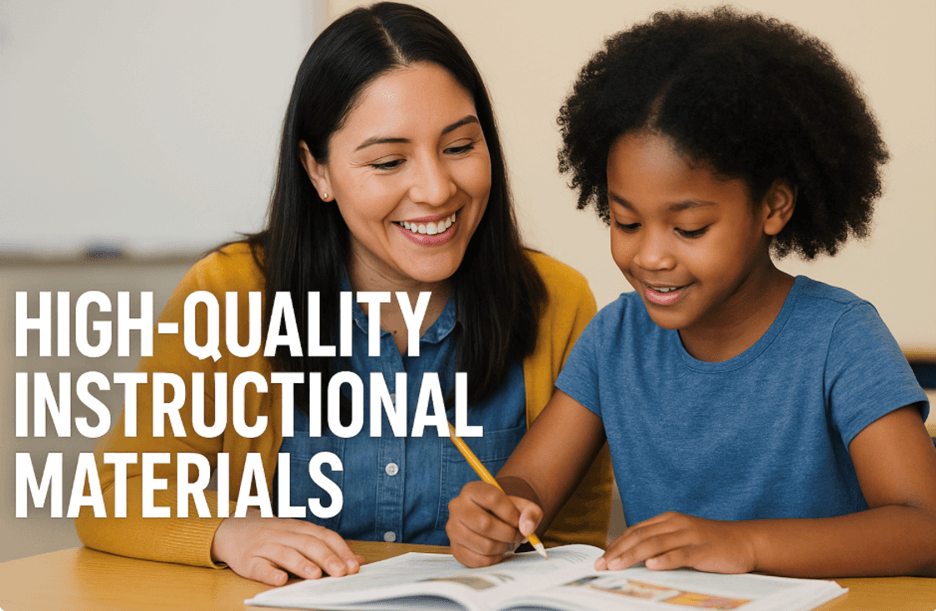Why High Quality Instructional Material (HQIM) Matters in 2025

Enhancing Student Engagement Through Superior Educational Content
If you’ve been in a school meeting lately, you’ve probably heard the term High-Quality Instructional Materials (HQIM). At first, it may sound like another piece of education jargon. But HQIM isn’t just a passing trend. It represents a shift in how schools in the United States and Canada think about curriculum, equity, and student success.
This blog will explain what HQIM means, how it works in the U.S. and Canada, and, most importantly, why it matters to educators in everyday classrooms. And, yes, SRSD is HQIM! I will talk all about that in our next blog.
Why HQIM Became a Priority
For decades, many teachers worked with a mix of materials: district-provided textbooks, their own lesson banks, and educational resources pulled from the internet. Some of those materials were excellent. Others were misaligned, inconsistent, or left gaps in instruction.
National studies revealed just how uneven this landscape was. Research from RAND found that teachers often rely on self-created lessons or websites like Teachers Pay Teachers, where quality and alignment vary widely. Meanwhile, state test scores and international benchmarks like PISA continued to show significant inequities in student learning outcomes.
Policymakers, researchers, and school leaders asked: What if we could guarantee every classroom access to strong, standards-aligned materials, regardless of zip code?
That question led to the rise of HQIM.
What Does HQIM Actually Mean?
The simplest way to define HQIM is: instructional materials that meet a high bar for alignment, usability, and equity.
Let’s break those words down:
- Aligned: HQIM connects directly to state or provincial standards. Teachers don’t have to guess if the lesson covers required skills.
- Coherent: Lessons build logically over time, helping students make connections and deepen understanding.
- Usable: Materials provide clear guidance so teachers can focus on teaching, not rewriting lessons.
- Equitable: HQIM includes supports and scaffolds so that multilingual learners, students with disabilities, and struggling readers can access the content.
In short, HQIM ensures that the “what” of teaching, the texts, tasks, and units we use, is as strong as possible.
HQIM in the United States
In the U.S., HQIM is closely tied to independent review organizations and state processes. The goal is to remove some of the guesswork from adoption decisions.
EdReports
EdReports is perhaps the best-known organization in this space. It publishes free K–12 ELA, math, and science curricula reviews. Expert reviewers, often classroom teachers, examine programs for alignment to college and career-ready standards, usability, and quality of instruction.
Districts can see at a glance whether a program meets expectations, partially meets expectations, or does not meet expectations. This transparency helps districts move beyond glossy marketing materials from publishers.
State-level Systems
Some states go further by running their own HQIM processes.
- Louisiana was an early leader, creating its own review rubric and encouraging districts to adopt only “Tier 1” materials.
- Massachusetts launched CURATE, where panels of teachers review programs and publish short, easy-to-use reports.
- Other states, like Texas and Tennessee, have also adopted vetting systems to steer schools toward high-quality curricula.
The trend is clear: more states are pressuring districts to adopt only programs with high-quality instructional materials and strong ratings through improved instructional design.
HQIM in Canada
Canada takes a different approach because education is a provincial responsibility. There is no national EdReports-style system. Instead, each province (and sometimes individual districts) handles resource approval.
Here are a few examples:
- Ontario: The Trillium List is the province’s official list of approved textbooks. Schools are expected to choose from this list for core subjects.
- Alberta: Schools use the Authorized Learning Resources database to find provincially approved resources.
- British Columbia: Approval is decentralized. Districts can choose resources, often using Focused Education Resources tools, which also evaluate materials for social considerations like cultural representation and inclusivity.
- Saskatchewan: The Ministry of Education publishes recommended or core resource lists aligned to the provincial curriculum.
- Nova Scotia: Teachers access the Nova Scotia School Book Bureau for authorized resources.
- Québec: The BAMD list is the official repository of approved didactic materials; schools must choose from it.
The systems look different, but the goals echo the U.S.: give teachers access to vetted, curriculum-aligned, and inclusive resources.
Why HQIM Matters for Teachers
It’s easy to think of HQIM as something only administrators worry about. But the reality is that the choice of materials impacts your daily teaching life. Here’s how:
1. HQIM Saves Time
Teachers often spend hours searching online for lessons. HQIM reduces this burden by providing ready-to-use lessons and teacher guides. Instead of reinventing the wheel, you can spend your prep time thinking about how to adapt materials for your students.
2. HQIM Builds Consistency across Classrooms
When everyone in a grade level or district uses the same strong materials, students benefit from a more consistent experience. This consistency matters when students move schools or when teachers collaborate across classrooms.
3. HQIM Supports Diverse Learners
Strong materials include scaffolds, visual supports, language routines, and multiple entry points. This ensures that multilingual learners, students with disabilities, and students at different readiness levels can all participate meaningfully.
4. HQIM Lets You Focus on the “How” of Teaching
Instead of worrying if the curriculum is aligned, you can put your energy into the strategies, routines, and relationships that bring learning to life.
Challenges and Criticisms
Of course, HQIM isn’t a magic wand. Teachers and leaders have raised some critical challenges:
- Implementation Takes Time: Even the best materials need strong professional learning for teachers. Without training, HQIM can feel overwhelming.
- Cost: High-quality programs often have a high price tag, limiting access in underfunded districts.
- Local Fit: Sometimes HQIM materials don’t match a community’s context or students’ cultural backgrounds. Teachers may need to adapt lessons to make them relevant.
- Over-Reliance on Programs: HQIM is powerful but not a replacement for teacher expertise. Materials are tools; teachers are the ones who make them work.
Recognizing these challenges helps schools avoid treating HQIM as a checklist item and instead focus on implementation that supports teachers and students.
Key Differences Between the U.S. and Canada
To recap, here’s how HQIM differs across the two countries:
- United States: HQIM is tied to large-scale review systems like EdReports and state-level processes like CURATE. Many states now encourage or require districts to adopt only “green-rated” materials.
- Canada: Each province manages its own system. While Ontario, Alberta, Québec, and others maintain official lists, British Columbia and some smaller provinces give districts more flexibility.
For teachers, the practical experience is similar: strong HQIM helps ensure access to aligned, usable, and inclusive resources.
What Teachers Can Do
Even though HQIM adoption often happens at the district or provincial level, teachers can play an active role. Here are a few ways:
- Ask Questions During Adoption: Does the curriculum align with standards? Does it include support for multilingual learners and students with disabilities?
- Advocate for Professional Learning: HQIM works best when paired with training. Ask your leaders what support will be provided.
- Adapt Thoughtfully: Strong materials are a foundation, but your students’ needs and effective pedagogy will always guide your choices. Use HQIM as a base and adapt where necessary.
- Collaborate Across Classrooms: Consistency is one of HQIM’s biggest strengths. Work with colleagues to ensure students are coherently experiencing strategies and routines.
The Bottom Line
HQIM is not just another buzzword. It’s a serious effort to ensure that what we teach students every day is rigorous, aligned, and inclusive.
In the U.S., this means using systems like EdReports and state adoption processes. In Canada, it means following provincial approval lists and resources.
But remember: materials alone don’t guarantee learning. The magic happens when strong materials meet strong teaching. Teachers bring HQIM to life through modeling, discussion, scaffolding, and support for diverse learners.
In other words: HQIM matters—but so do you.
Sources for Further Reading
- EdReports HQIM Reviews
- Massachusetts CURATE
- RAND American Teacher Panel
- Ontario Trillium List
- Alberta Authorized Learning Resources
- Focused Education Resources (BC)
- Nova Scotia School Book Bureau

About the Author
Randy Barth is CEO of SRSD Online, which innovates evidence-based writing instruction grounded in the Science of Writing for educators. Randy is dedicated to preserving the legacies of SRSD creator Karen Harris and renowned writing researcher Steve Graham to make SRSD a standard practice in today’s classrooms. For more information on SRSD, schedule a risk-free consultation with Randy using this link: Schedule a time to talk SRSD.





